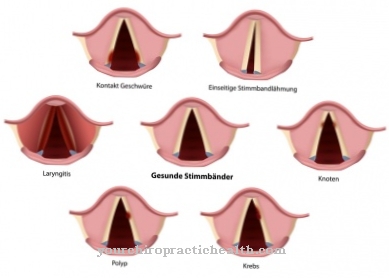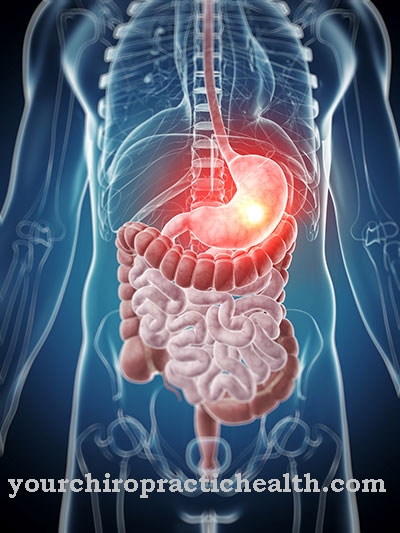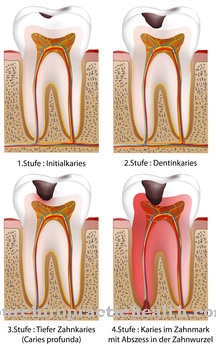Under the term Ventilation disorders In human medicine, disorders in inhalation and exhalation are summarized. A distinction is made between obstructive, restrictive and neuromuscular ventilation disorders. An increase in airway resistance is referred to as obstructive, a reduction in vital capacity or total lung capacity is referred to as restrictive, and a neuromuscular motor restriction of breathing is referred to as neuromuscular.
What are ventilation disorders?
The designation Ventilation disorder is used in human medicine to hinder breathing due to increased breathing resistance as well as to reduce lung capacity - and thus also for reduced vital capacity. Increased breathing resistance can result from obstructions in the airways or from external pressure on the airways.
Such airway resistance is referred to as obstructive. A restrictive ventilation disorder is when the lung volumes are restricted due to a change in the functional lung tissue. Likewise, an obstruction to breathing due to neuromuscular diseases or injuries to the chest corresponds to a restrictive ventilation disorder.
As a rule, it is a question of a reduced compliance of the respiratory system and thus also a reduced vital capacity. Both mechanical-muscular and neuromuscular problems with breathing as well as a change in the functional tissue (parenchyma) of the lungs and bronchi are referred to as restrictive ventilation disorders.
Neuromuscular ventilation disorders are restrictions caused by the nervous system, such as those that can occur with paraplegia or with a disruption of the higher-level respiratory centers in the brain.
causes
The triggering factors of a ventilation disorder are very different. They can be differentiated between the cause of an obstructive, restrictive or neuromuscular disorder. For example, allergic bronchial asthma and chronic obstructive pulmonary disease (COPD) lead to a classic form of obstructive ventilation disorder.
Both diseases cause swelling of the mucous membranes, thickening of the contracting bronchial muscles and the secretion of viscous mucus to reduce the lumen in the bronchi, so that the airway resistance increases. Constrictions in the airways, for example caused by structures that take up space such as tumors, are also counted among the obstructive ventilation disorders. The causes of a classic restrictive ventilation disorder include pulmonary fibrosis, paralysis or stiffening of the diaphragm or pleural effusion.
A characteristic of pulmonary fibrosis, which can have many different causes, is the gradual remodeling of the functional lung tissue into connective tissue-like structures with a gradual loss of function. A number of possible causative factors are also responsible for the pleural effusion, an excessive accumulation of fluid between the two sheets of the pleura.
Symptoms, ailments & signs
Signs and symptoms of a ventilation disorder cover a wide range and are largely dependent on the underlying disease or the causative factors. For example, chronic bronchitis, which can develop into COPD, manifests itself as a productive cough that can last for years.
In addition, exertional dyspnea often becomes apparent as the disease progresses. If the disease is severe, dyspnea at rest can also show up. A ventilation disorder caused by an acute asthma attack can cause acute shortness of breath because the airways are almost completely blocked.
Persistent coughing, increased pulse rate and pronounced cyanosis with blue lips can be assessed as secondary symptoms that develop due to the reduced oxygen supply. The remaining causes of an obstructive or restrictive ventilation disorder are usually characterized by unspecific exercise or resting dyspnea and by an urge to cough that is associated with increased mucus formation.
Diagnosis & course of disease
Ventilation disorders are always an expression of different underlying diseases, so that the determination of an obstructive, restrictive or neuromuscular ventilation disorder often does not contain any information about the causative factors. A large number of diagnostic aids are available within a lung function test such as spirometry with measurement of the vital capacity and various static and dynamic parameters for the detection of a ventilation disorder.
The so-called body plethysmography or whole-body plethysmography, which requires a closed cabin with specialized technology, is a little more complex. The procedure provides information about the pressure conditions in the chest and the airway resistance as well as some other parameters such as the total capacity of the lungs and residual volume that cannot be exhaled. The course of a ventilation disorder depends on the underlying disease causing it. In the case of COPD or pulmonary fibrosis, if left untreated, it can lead to a severe course with an unfavorable prognosis.
Complications
Depending on the cause, a ventilation disorder can cause various respiratory complications. If the disorder occurs, for example, as part of chronic bronchitis, the typical symptoms, i.e. cough, sputum and shortness of breath, increase in the course of the disease and are associated with a shortened life expectancy. A possible secondary disease is tachycardia, a pathological palpitations that can lead to further diseases of the cardiovascular system.
Furthermore, in connection with persistent ventilation disturbance, cyanosis can occur, in which the skin turns blue. In the course of the disorder, exertional dyspnea or resting dyspnea often occurs if the underlying disease is severe. Ventilation disorders in the context of an acute asthma attack can lead to acute shortness of breath. In extreme cases, symptoms of suffocation and a panic attack occur.
An untreated disturbance of the ventilation is particularly problematic, because in the later stages this can cause consequential damage to the brain (due to chronic oxygen depletion) and to the lungs. During treatment, the risks come mainly from the drugs prescribed, which are often associated with side effects and interactions.
When should you go to the doctor?
Breathing disorders should always be clarified by a doctor if they persist for several weeks or months. Consult a doctor immediately in the event of acute respiratory distress. If there is a loss of consciousness due to the lack of oxygen, an ambulance service must be alerted. In addition, those present must use mouth-to-mouth resuscitation from the first aid catalog. This is the only way to ensure the survival of the person affected. Dizziness, unsteady gait, general weakness or disturbances in attention and concentration indicate health irregularities that should be clarified by a doctor.
Pale skin, irregular heartbeat and sleep disorders are other complaints that need to be investigated. Heavy breathing, interruptions in breathing and general dysfunction are signs of a ventilation problem. A diagnosis with a doctor is necessary so that a treatment plan can be drawn up. If the day-to-day obligations cannot be fulfilled or if problems arise in coping with sporting tasks, it is advisable to clarify the cause.
In the event of an internal feeling of pressure, general malaise or rapid fatigue, the observations should be discussed with a doctor. The loss of joie de vivre, apathy and withdrawal from social life should be interpreted as warning signals. A doctor's visit is advisable so that the reasons for the health impairments can be determined.
Treatment & Therapy
The treatment of a ventilation disorder is always geared towards the treatment of the underlying disease causing it. If it is one from long-term inhalation of toxic fumes or dusts or from cigarette smoke, the first part of therapy is to avoid the substances in the future. The next stage of treatment usually consists of treatment with beta2 mimetics, so-called bronchodilators, so that the vascular muscles of the airways loosen and the airways widen.
The medication can also be taken in the form of breath sprays. This has the advantage that the active ingredient is easily applied directly to the affected tissue. If chronic airway inflammation is one of the causes of the ventilation disorders, corticosteroids are often used. However, with long-term use of cortisone, its side effects must be taken into account, which can include a weakening of the immune system against infection.
In some cases, in which there is already a chronic undersupply of oxygen, an additional oxygen supply using a mask may be necessary. In very severe cases, for example, surgical interventions can reopen or bypass narrowed and completely obstructed airways. As a last resort, lung transplants are also carried out in the event of non-treatment.
You can find your medication here
➔ Medication for shortness of breath and lung problemsprevention
There are no direct preventive measures that could prevent a ventilation disturbance, because the disease is either based on a causative underlying disease or on the inhalation of long-term toxic dusts or aerosols. If it is not possible to keep away from certain toxic substances - including cigarette smoke - it is advisable to carry out lung function tests at regular intervals of around three to five years.
The ventilation disorder is an everyday burden for the patient. Due to frequent breathing difficulties, many sufferers are dependent on breathing apparatus. Follow-up care is advisable to restore or maintain quality of life. The patient should be trained in the daily use of breathing aids. At follow-up appointments, he learns the correct use of such aids.
Aftercare
A ventilation disturbance can have acute and chronic causes. The duration and extent of follow-up therefore depend on the underlying disease. For chronic lung diseases such as COPD or bronchial asthma, close follow-up care is required, and the pulmonologist applies it long-term. In the event of an acute trigger, the actual illness is eliminated.
As part of the follow-up care, the specialist checks whether there is an improvement in the condition. The follow-up examinations are continued until the symptoms have subsided. Soothing medication is prescribed to the patient against secretion and coughing. In addition, follow-up care also includes people close to you.
You will be informed of first aid measures. Acute respiratory distress can be recognized in good time and first aid can be provided. A balanced diet rich in vitamins, avoidance of too high a stress level and going to self-help groups all contribute to improving the condition. In this case, follow-up care is more like preventive care.
You can do that yourself
Depending on the severity of the underlying disease, a ventilation disorder can significantly reduce the quality of life of the affected person. From a psychological point of view, it is primarily important to maintain the social environment.
A sudden worsening of the disease can lead to incapacity for work and social problems. The result is often depression and a further deterioration in health. The exchange with other affected persons in forums or self-help groups breaks this downward spiral. Those affected not only find experience there, but also receive up-to-date information on doctors, sports groups and other contact points.
From a medical point of view, the patient's adherence to therapy is particularly important. Regular discussions with the doctor make it easier to carry out a well-coordinated therapy. Special exercise in the lungs is particularly important when there is a ventilation problem. Sufferers can support these measures themselves by doing sports at home and staying physically active. In addition, general measures such as adequate rest and avoidance of stress apply. The diet may need to be adjusted to cope with the progressively advancing disease. The Association COPD Germany e. V. can provide those affected with further tips and measures for the treatment of a ventilation disorder.


.jpg)





















.jpg)



